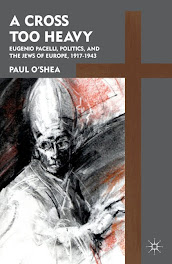Continuing along the theme of "what did the pope know and when" I think it important to note that Pius and his Secretariat of State were given quite detailed descriptions of the horrors inflicted upon civilian populations from the earliest days of the war. This document is a report sent by the Nuncio in Germany, Cesare Orsenigo to Cardinal Maglione describing the visit to Warsaw made by Carlo Colli, a member of the Berlin nunciature staff. Colli had served in the Warsaw nunciature between 1924 and 1932 before his transfer to Berlin. While it may be assumed he had some grasp of Polish, he appears to have communicated in French and German.
Colli had been given permission by the German government to travel to Warsaw to inspect damage to the nunciature buildings. He left Berlin on 14 October, two weeks after the Wehrmacht occupied the city, and stayed until 17 October. In three days Colli saw first hand the devastation visited upon Warsaw, the massive destruction of buildings, infrastructure and all basic utilities. He spent time with the Vicar General of the Archdiocese of Warsaw, Bishop Stanislaw Gall and met with priests and religious who had been detained and arrested by the Gestapo.
What makes the report so significant is its timing and the lack of concern that the Germans appear to have had over a nunciature representative visiting a German-occupied city that was still very much in a state of shock and deep trauma. Colli wrote of mass graves in the city squares, where flowerbeds had been dug up; of dazed people wandering the bombed out streets; and the huge number of unknown dead who lay beneath the rubble of still collapsing buildings.
Colli was astounded at the number of civilian casualties, many of whom had been killed by the indiscriminate strafing indulged by the Luftwaffe. This was something new in warfare.
Towards the end of the report there is an ominous warning: winter was approaching and the first snow had fallen in the city. Archbishop Gall appealed for help from Poles living in the United States.
Orsenigo's language reveals, I believe, an air of disbelief at the level of destruction and loss of life, but is also relatively calm as though this was an aberration and not likely to be repeated. Nonetheless, by mid-October, the Pope had first-hand knowledge of what was to become an all too familiar pattern of Nazi barbarity against the people of Eastern Europe. There is no mention of anti-Jewish persecution in Warsaw, most likely because the first major anti-Jewish action did not occur until November with the order to wear the Star of David on a white armband. In October things were still chaotic in the immediate post-battle environment.
The full text may be found in the pages section.
Colli had been given permission by the German government to travel to Warsaw to inspect damage to the nunciature buildings. He left Berlin on 14 October, two weeks after the Wehrmacht occupied the city, and stayed until 17 October. In three days Colli saw first hand the devastation visited upon Warsaw, the massive destruction of buildings, infrastructure and all basic utilities. He spent time with the Vicar General of the Archdiocese of Warsaw, Bishop Stanislaw Gall and met with priests and religious who had been detained and arrested by the Gestapo.
What makes the report so significant is its timing and the lack of concern that the Germans appear to have had over a nunciature representative visiting a German-occupied city that was still very much in a state of shock and deep trauma. Colli wrote of mass graves in the city squares, where flowerbeds had been dug up; of dazed people wandering the bombed out streets; and the huge number of unknown dead who lay beneath the rubble of still collapsing buildings.
Colli was astounded at the number of civilian casualties, many of whom had been killed by the indiscriminate strafing indulged by the Luftwaffe. This was something new in warfare.
Towards the end of the report there is an ominous warning: winter was approaching and the first snow had fallen in the city. Archbishop Gall appealed for help from Poles living in the United States.
Orsenigo's language reveals, I believe, an air of disbelief at the level of destruction and loss of life, but is also relatively calm as though this was an aberration and not likely to be repeated. Nonetheless, by mid-October, the Pope had first-hand knowledge of what was to become an all too familiar pattern of Nazi barbarity against the people of Eastern Europe. There is no mention of anti-Jewish persecution in Warsaw, most likely because the first major anti-Jewish action did not occur until November with the order to wear the Star of David on a white armband. In October things were still chaotic in the immediate post-battle environment.
The full text may be found in the pages section.
Warsaw, October 1939





No comments:
Post a Comment
You are welcome to post a comment. Please be respectful and address the issues, not the person. Comments are subject to moderation.